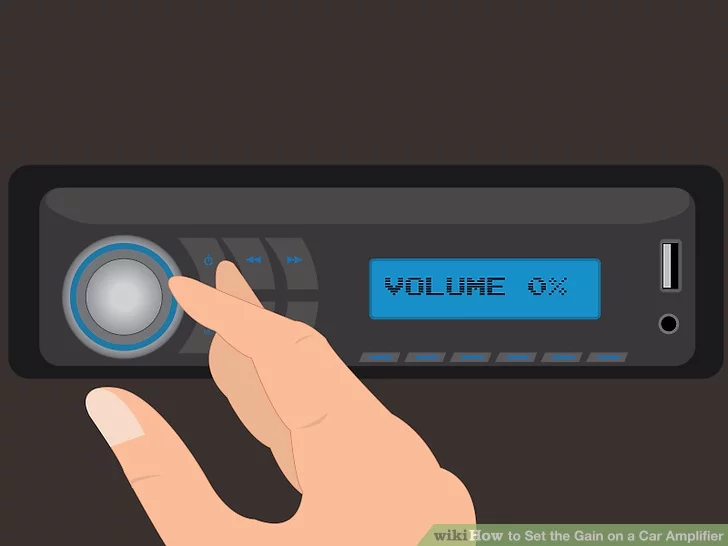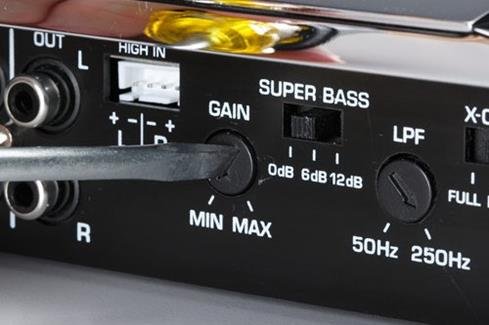A well-adjusted amplifier gain eliminates sound clipping and other poor sound outputs. But adjusting a car amplifier gain has not been the easiest task for car owners. When adjusted to the right frequency, your gain matches your amp input level with your stereo output levels, thereby producing just the right sound for your car. How to adjust car amplifier gain for the best performance?
Adjusting a car amplifier gain has a simple option and a complex option, which requires a bit of calculation. Nonetheless, you can adjust your car amplifier gain by simply adjusting the stereo volume to reach 70% capacity and the gain volume to a preferred high level, and then readjust the volume button to suit your preference and the current music. This method of gain adjustment can be done without sound tools.
While our ears are great for detecting and adjusting sound, most car owners rely on tools to help them adjust their amp gain.
Table of Contents
Others Ways Of Adjusting Your Car Amp Gain
The only guaranteed means of enjoying quality sound from your stereo system is adjusting it with a tool or music. A well-adjusted amplifier gain means enjoying the full range of any music playing in your car. It also means enjoying the notes, thereby assuring the best music experience in your car.
● Adjust Gain With Music
The easiest way to adjust your amplifier gain is by listening to music in your car.
Play a familiar song and find distortions while you adjust the volume and gain buttons. Start by turning both the volume and gain button down. Once you’re sure that your volume and gain buttons are down, turn on your stereo and play your favorite song.
You should play a song you’re familiar with as it helps you judge the quality of the sound and aids the discovery of sound distortions. Next, you’ll need to turn the volume button back up, but not to full capacity as it could cause distortions from your amp.
Rather, leave it at 70% while slowly turning up your gain volume to a preferred high volume. Find distortions as you tweak the gain button and then leave the gain control below that level.
Without the distortions from the gain, you can simply use your volume button to adjust the music to a preferred level. Note: your gain button is not a volume button. While it might be tempting to tweak your gain button for maximum sound, avoiding it will help prevent distortions in your music.
● Adjust Gain With Test Tone
While adjusting your amp gain with your favorite song and your ear might yield good results, adjusting with test tone has been known to yield more satisfactory results. A more cumbersome option but one that guarantees amazing sound output.
A test tone indicates a single note being played at a particular frequency and can be downloaded from trusted websites to test your amp gain. The test results can be derived in two ways, either through a Speaker or an Oscillator.
A test tone with a speaker is a cheaper and more realistic way to adjust amplifier gain. But first, you should level your amp’s bass boost and EQ receiver volume. Play the test tone and adjust the gain button until there is a buzzing sound. Slightly return the volume and wait for the humming sound a test tone produces.
The second option, test tone with an Oscilloscope screen, is considered the best option as it provides the user with a clear image of the sound wavelength, thereby showing the clear points and distorted points. This provides you with accurate data for adjusting your amplifier gain.
● Adjust Gain With Digital MultiMeter
A digital multimeter helps to adjust amp gain by accurately matching your amps input level with your stereo’s output level. This method of adjusting amp gain is more accurate but requires a bit of maths to test the output of your amplifier’s AC voltage.
Here are the steps to follow:
1. Disconnect all accessories
Disconnect your subwoofers and speakers from your car amplifier, while leaving it plugged in. It is recommended to remove only the positive terminals of your accessories.
2. Equalizer and Gain setting to zero
The next step is to completely turn off your equalizer or turn the settings such as Loudness, Bass Boost, equalizer functions, and Treble.
3. Measure Speaker Resistance
Next, test the resistance of your speakers by connecting to your amp using a multimeter. But first, determine the positive and negative terminals of your amp before connecting the black probe to the negative and the red to the positive. Settle for any ohm resistance between 2, 4, 8, or 16 ohms.
4. Check for the speaker’s recommended wattage
After measuring your speaker’s resistance, the next step is to check for your speaker’s recommended wattage to make sure it is balanced with your ohm resistance for optimal tests results.
5. Calculate the Required A.C Voltage
Next, we do the maths. Calculate the target voltage of your amp by using a variation of Ohm’s law where V = √(P.R) and V is the target voltage and P, the wattage with R being the resistance. To derive a conclusion, multiply your Watts with the Ohm, and find the square too of your answer.
6. Set Volume to ⅔
Next, set the volume at ⅔ of its full capacity. Most authorities recommend that you set your stereo volume to 70 or 75% to prevent hearing distorted sounds.
7. Insert Multimedia Probe
Insert the negative probe and positive probes into the corresponding terminals of your car amplifier.
8. Play Tone
As a last and conclusive step, play a 6p Hz test tone on your stereo. You can buy a CD or download a tone online. Adjust the gain button until the multimedia reads the desired Ac Output voltage. Enjoy music on your Stereo like never before.
Tips for Adjusting Amplifier Gain
You should follow the steps as it is for the best results. However, below are some additional tips to help you adjust your amplifier gain correctly.
1. Don’t Maximize Stereo Volume
As mentioned earlier, keep your stereo volume at ⅔ of its full capacity. For example, if your maximum volume is 100, then it should be 70% to avoid sound distortion while testing your amplifier gain.
2. Set Your Separate Amplifier Gain Individually
If you own more than 1 amplifier in your car, setting them individually helps to get the best results. By so doing, you easily identify the amplifier causing the distortion and adjust it accordingly. Adjusting all the gains on all your amplifiers at the same time will only increase your workload and reduce the efficiency of the test.
How to tune For Bass Sound?
More car owners are constantly looking for new ways of amping up their bass car stereo as it provides them the best in-car listening experience. But how do you tune for bass sound?
The first step to tuning for bass sound in your car stereo is eliminating the distortion. Adjust the stereo volume until you notice a distorted sound. Then slightly tune it down until you no longer hear the distortion. Next, turn off the bass boost and low pass filter.
Play your music at ¼ and slowly turn up your subwoofers until you hear the distortion, and tune it back down until you can only hear the clear sound of the bass in your music.
Adjusting your amplifier gain helps you enjoy clear sound. The best methods to adjust your gain includes music (listening), test tone, and a multimeter. However, for the best results, we recommend an oscilloscope to test tone or multimedia, which involves a bit of calculation.
Pay attention to the warnings and use these methods by the stayed precautions by your car manufacturer. Be quick to visit a professional in the case of a malfunction to avoid any further damage to your amplifier.



